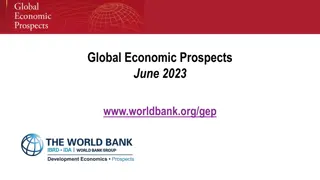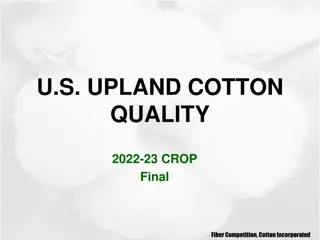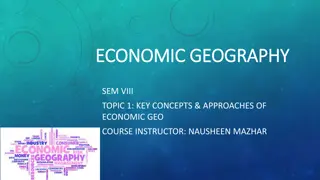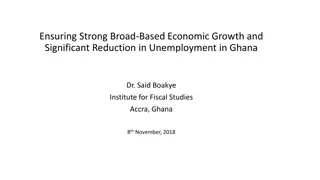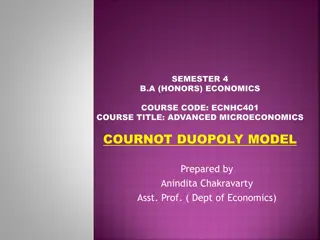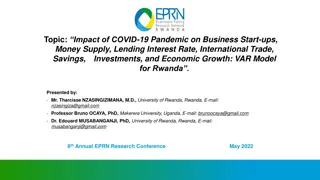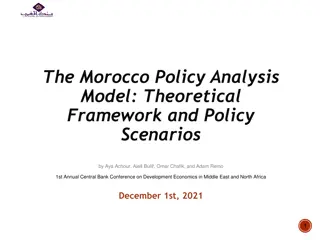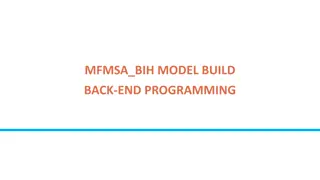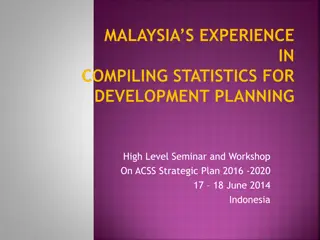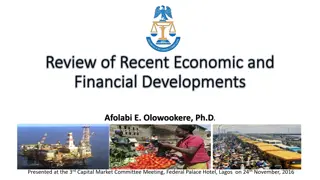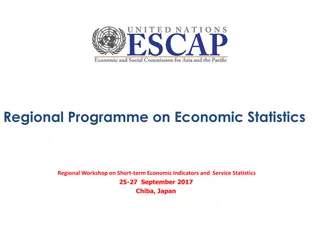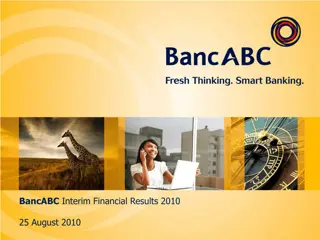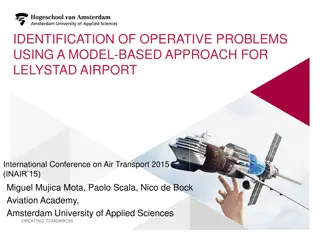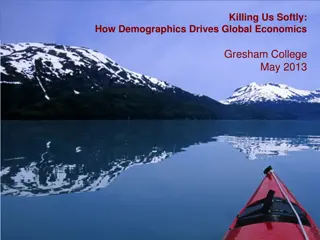Comprehensive Analysis of MARA Model and Future Economic Trends
This content provides an overview of the MARA Model, focusing on identifying revenue challenges, exploring long-term expenditures, creating data sets for analysis, and proposing potential solutions. It also discusses the impact of technology on the economy, demographic trends, energy economy changes, and more. The 2040 MARA Model offers insights into future scenarios, while the Outlook compares different time frames and levels of detail in forecasting economic trends. Additionally, it outlines fiscal principles for lawmakers when constructing long-term budgets.
Uploaded on Oct 05, 2024 | 0 Views
Download Presentation

Please find below an Image/Link to download the presentation.
The content on the website is provided AS IS for your information and personal use only. It may not be sold, licensed, or shared on other websites without obtaining consent from the author. Download presentation by click this link. If you encounter any issues during the download, it is possible that the publisher has removed the file from their server.
E N D
Presentation Transcript
MARA Model INVENTION WITH INTENTION TIMING
HB 330 MARA Charge (a) identifying structural revenue challenges with economic, demographic, and geographical variability considerations; (b) exploring revenue sufficiency and probable long-term expenditures by state and local government... (c) creating data sets and models for future analysis by the legislature; and (d) proposing potential solutions and possible legislation for consideration by the 2023 legislature
Progress to Date Speakers on various topics How technology will impact the future economy Population and demographic trends supported by data Potential changes to the energy economy supported by data Change in education, health, land use, property tax, and other topics Cost of living trends including housing and childcare Data on various topics were presented Model planning has been underway, but not brought to the committee till now
2040 MARA MODEL IS Tool to provide insights to the future IS NOT Not a precise calculation of revenues or costs in the future Pinch points Not tell the legislature what it should do Values in context Example how big of a problem shortfalls in gas tax be in comparison to shortfall in capacity at the state prison Not a budget
Outlook versus MARA Model OUTLOOK 2040 MARA MODEL 3-5 years out 18 years out Relatively detailed Less detail but covers all state, local & schools Focused on state general fund Considers more global trends Focused on present law, but also introduces expenditure pressures Considers items beyond present law in order to capture demands anticipated with the new economy and other trends Primarily internal LFD work, with relatively little outside input Looped through various committees and stakeholders for input
Outlook 2025/2027 is more detailed The recent Pew memo offers state lawmakers six fiscal principles to follow when constructing a long- term budget: Analyzing major revenue sources and spending categories. Looking ahead at least three years. Estimating baseline revenue and spending, using present law and current services approaches to anticipate the amount of funding needed to maintain consistent service levels for programs in future years. Accounting for the effects of potential policy changes. Distinguishing between one-time and ongoing revenue and expenditures to estimate structural balance. Identifying the key factors driving the state s structural position.
M - Modular include modules of significant revenue and cost drivers of state and local policy and financial areas I - Inclusive open communication with legislative committees, local governments, stakeholders, and experts 2040 MARA Model D - Data-driven forecasting data from State Accounting Budget & Human Resource System (SABHRS) for state and local, IHS Markit, Regional Economic Models Inc. (REMI) population, K-12 education, Department of Revenue, others M I D I L I - Insightful - Uses and considers advances in technology, modern consumer preferences, population L - Long-term outlook looking forward from present to 2040
Education Property tax Public Safety 2040 MARA Model Tax and revenue Public Works MODULAR Infra- structure Health
INCLUSIVE Vetting all aspects Stakeholders Legislative Committees Agencies Budget Office Local Governments, including schools Experts in complex modeling and experts in analysis Pew Public
DATA DRIVEN primary data sets IHS Markit economic forecasting data that includes labor, population, inflation, and many others Accounting data - state SABHRS, local reports to DOA and school reports to OPI Department of Revenue and Justice tax, including detailed property tax data REMI population forecasts by county IHS Markit, NW Power Planning, Princeton Net Zero America for scenarios of the energy economy System Actuarial reports for pension assumptions Census definitions for state, local, and school accounting data Other federal and state data sets
INSIGHTFUL The input from all the speakers over the past year Input from all stakeholders, legislators, agencies, experts Develop trended costs and revenues As time allows model more details and scenarios
Scenarios impacting global variables Energy economy Population growth Pension Funding IHS Markit NW Power and Conservation Council Power Plan Princeton Net Zero America alternate energy options IHS Markit Alternate IHS Markit REMI Current law Shorter amortization at higher rate, from system actuarial analysis
Population by County Global Variables that are used to model the future Market value by class by county Personal Income by county Green are dynamic and changes with various scenarios, these are examples, there will be additional variables Global Variables Gray, automation, is not dynamic and it is uncertain if we will find a way to incorporate this element Per capita personal income by county Pension costs by system Automation Labor/Tech
Model Process Modeled Output Scenarios IHS Markit Accounting data Other Population Economy Reference Energy Population Pensions Income tax $ Property tax $ Expenditures $ Global Variables Data
LONG-TERM to 2040 Reference Case Revenue and Expenditure Example Reference Case 4 3.5 3 2.5 The future is unknown 2 Reference case and multiple scenarios 1.5 1 0.5 0 2025 2030 2035 2040 Revenue Expenditure
More about the model and how it will work NICK VANBROWN LEAD ANALYST - DATA
Forecast Modules Modeling Attach to Financial Data
Education Property tax Public Safety 2040 MARA Model Tax and revenue Public Works Infrastructure Health Health
Medicaid HEALTH EXAMPLE
Example: Health Number of Participants in that year Medicaid Cost in a given Year Cost Per Participant in that Year
Number of Participants in that year Example: Health Percentage of Population Medicaid Population Groups % Adult Adult % Child Child % Disabled Disabled Over 65 % Over 65 Adult Expansion % Adult Expansion
Number of Participants in that year Example: Health Forecasted Population Percentage of Population % Adult Adult % Child Child % Disabled Disabled % Over 65 Over 65 % Adult Expansion Adult Expansion
Example: Health Number of Participants in that year
Example: Health Number of Participants in that year Medicaid Cost in a given Year Cost Per Participant in that Year
Cost Per Participant in that Year Example: Health Medicaid Cost $ Per Adult $ Per Child $ Per Disabled $ Per Over 65 $ Per Adult Expansion
Example: Health Number of Participants in that year Medicaid Cost in a given Year Cost Per Participant in that Year
Input and Feedback Committees Agencies Education OBPP Property tax Public Safety Stakeholders 2040 MARA Model Contractors Tax and revenue Public Works Infrastructure Health
Modules Everything Else Education Public Safety State Data Property tax Personal Services 2040 MARA Model Tax and revenue Public Works Operating Infrastructure Health Equipment & Assets
State Data Personal Services Operating Equipment & Assets
Forecast Modules Modeling Attach to Financial Data
Business Intelligence Software Link Data Sets
Business Intelligence Software Link Data Sets Time
Business Intelligence Software Link Data Sets Time Location
Business Intelligence Software Accounting data from SABHRS Nightly Link Data Sets Time Location Regular Updates IHS Markit economic forecasting data Monthly Department of Revenue Property Tax Data Annually REMI population forecasts by county Biannually
Business Intelligence Software Link Data Sets Time Location Regular Updates Visualize Modules Roll Up
Business Intelligence Software Link Data Sets Time Location Regular Updates Visualize Modules Roll Up Define Variables Modular Global
EXAMPLE Population GLOBAL VARIABLE
Demographic Age Change
ON Scenarios OFF
Forecast Modules Modeling Attach to Financial Data
Financial Data Sets 1. State Accounting Data (SABHRS) 2. School Accounting Data (Trustee Reports) 3. Local Government Accounting Data (Financial Reports)
STATE ACCOUNTING DATA
SABHRS Breakout Example SABHRS Data Medicaid Other Modules All Else
SABHRS Breakout Example SABHRS Data Medicaid Other Modules All Else History
Pulling it Together Forecast Modules Modeling Financial Forecast History
Reference Case Scenarios Discussion In The End
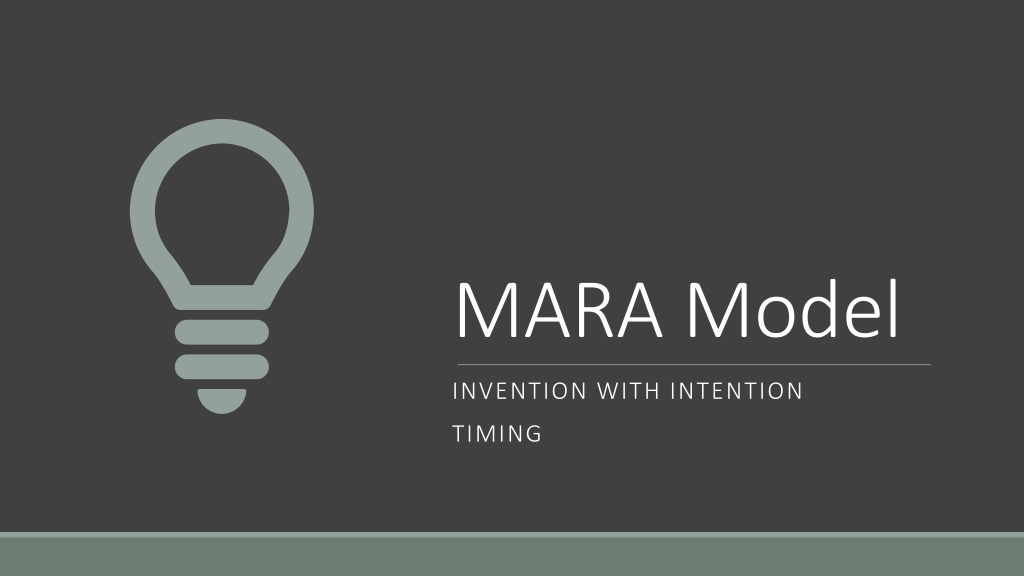
 undefined
undefined

















